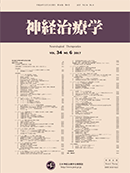33 巻, 2 号
選択された号の論文の73件中1~50を表示しています
-
2016 年 33 巻 2 号 p. 67-70
発行日: 2016年
公開日: 2016/08/10
PDF形式でダウンロード (339K) -
2016 年 33 巻 2 号 p. 71-73
発行日: 2016年
公開日: 2016/08/10
PDF形式でダウンロード (451K)
第33回日本神経治療学会総会特集1
-
2016 年 33 巻 2 号 p. 75-82
発行日: 2016年
公開日: 2016/08/10
PDF形式でダウンロード (598K)
会長講演
-
2016 年 33 巻 2 号 p. 83-87
発行日: 2016年
公開日: 2016/08/10
PDF形式でダウンロード (920K)
理事長講演
-
2016 年 33 巻 2 号 p. 88-90
発行日: 2016年
公開日: 2016/08/10
PDF形式でダウンロード (392K)
特別講演
-
2016 年 33 巻 2 号 p. 91
発行日: 2016年
公開日: 2016/08/10
PDF形式でダウンロード (201K) -
2016 年 33 巻 2 号 p. 92
発行日: 2016年
公開日: 2016/08/10
PDF形式でダウンロード (189K)
教育講演
-
2016 年 33 巻 2 号 p. 93
発行日: 2016年
公開日: 2016/08/10
PDF形式でダウンロード (179K) -
2016 年 33 巻 2 号 p. 94-98
発行日: 2016年
公開日: 2016/08/10
PDF形式でダウンロード (454K) -
2016 年 33 巻 2 号 p. 99
発行日: 2016年
公開日: 2016/08/10
PDF形式でダウンロード (175K) -
2016 年 33 巻 2 号 p. 100-104
発行日: 2016年
公開日: 2016/08/10
PDF形式でダウンロード (1365K) -
2016 年 33 巻 2 号 p. 105-108
発行日: 2016年
公開日: 2016/08/10
PDF形式でダウンロード (591K) -
2016 年 33 巻 2 号 p. 109
発行日: 2016年
公開日: 2016/08/10
PDF形式でダウンロード (203K)
マラソンレクチャー
-
2016 年 33 巻 2 号 p. 110-114
発行日: 2016年
公開日: 2016/08/10
PDF形式でダウンロード (1006K) -
2016 年 33 巻 2 号 p. 115-121
発行日: 2016年
公開日: 2016/08/10
PDF形式でダウンロード (3133K) -
2016 年 33 巻 2 号 p. 122
発行日: 2016年
公開日: 2016/08/10
PDF形式でダウンロード (197K) -
2016 年 33 巻 2 号 p. 123
発行日: 2016年
公開日: 2016/08/10
PDF形式でダウンロード (214K) -
2016 年 33 巻 2 号 p. 124
発行日: 2016年
公開日: 2016/08/10
PDF形式でダウンロード (195K) -
2016 年 33 巻 2 号 p. 125-130
発行日: 2016年
公開日: 2016/08/10
PDF形式でダウンロード (2526K) -
2016 年 33 巻 2 号 p. 131-133
発行日: 2016年
公開日: 2016/08/10
PDF形式でダウンロード (349K) -
2016 年 33 巻 2 号 p. 134
発行日: 2016年
公開日: 2016/08/10
PDF形式でダウンロード (136K) -
2016 年 33 巻 2 号 p. 135-140
発行日: 2016年
公開日: 2016/08/10
PDF形式でダウンロード (1465K) -
2016 年 33 巻 2 号 p. 141
発行日: 2016年
公開日: 2016/08/10
PDF形式でダウンロード (186K) -
2016 年 33 巻 2 号 p. 142
発行日: 2016年
公開日: 2016/08/10
PDF形式でダウンロード (199K)
メディカルスタッフ教育講演(疾患シリーズ)
-
2016 年 33 巻 2 号 p. 143
発行日: 2016年
公開日: 2016/08/10
PDF形式でダウンロード (212K) -
2016 年 33 巻 2 号 p. 144
発行日: 2016年
公開日: 2016/08/10
PDF形式でダウンロード (208K) -
2016 年 33 巻 2 号 p. 145-149
発行日: 2016年
公開日: 2016/08/10
PDF形式でダウンロード (448K) -
2016 年 33 巻 2 号 p. 150-154
発行日: 2016年
公開日: 2016/08/10
PDF形式でダウンロード (2833K) -
2016 年 33 巻 2 号 p. 155-157
発行日: 2016年
公開日: 2016/08/10
PDF形式でダウンロード (956K) -
2016 年 33 巻 2 号 p. 158-161
発行日: 2016年
公開日: 2016/08/10
PDF形式でダウンロード (813K)
シンポジウム1:難治性ニューロパチー治療に対する現状と展望
-
2016 年 33 巻 2 号 p. 162
発行日: 2016年
公開日: 2016/08/10
PDF形式でダウンロード (212K) -
2016 年 33 巻 2 号 p. 163-166
発行日: 2016年
公開日: 2016/08/10
PDF形式でダウンロード (433K) -
2016 年 33 巻 2 号 p. 167
発行日: 2016年
公開日: 2016/08/10
PDF形式でダウンロード (197K) -
2016 年 33 巻 2 号 p. 168-171
発行日: 2016年
公開日: 2016/08/10
PDF形式でダウンロード (366K) -
2016 年 33 巻 2 号 p. 172-175
発行日: 2016年
公開日: 2016/08/10
PDF形式でダウンロード (638K)
シンポジウム2:iPS細胞を用いた神経疾患の最新研究
-
2016 年 33 巻 2 号 p. 176
発行日: 2016年
公開日: 2016/08/10
PDF形式でダウンロード (189K) -
2016 年 33 巻 2 号 p. 177-181
発行日: 2016年
公開日: 2016/08/10
PDF形式でダウンロード (1094K) -
2016 年 33 巻 2 号 p. 182
発行日: 2016年
公開日: 2016/08/10
PDF形式でダウンロード (178K) -
2016 年 33 巻 2 号 p. 183
発行日: 2016年
公開日: 2016/08/10
PDF形式でダウンロード (168K)
シンポジウム3:神経疾患克服を目指した最新の画像研究
-
2016 年 33 巻 2 号 p. 184
発行日: 2016年
公開日: 2016/08/10
PDF形式でダウンロード (234K) -
2016 年 33 巻 2 号 p. 185
発行日: 2016年
公開日: 2016/08/10
PDF形式でダウンロード (237K) -
2016 年 33 巻 2 号 p. 186-190
発行日: 2016年
公開日: 2016/08/10
PDF形式でダウンロード (1563K) -
2016 年 33 巻 2 号 p. 191
発行日: 2016年
公開日: 2016/08/10
PDF形式でダウンロード (185K) -
2016 年 33 巻 2 号 p. 192-193
発行日: 2016年
公開日: 2016/08/10
PDF形式でダウンロード (282K)
シンポジウム4:認知症治療に向けた新たな病態の理解
-
2016 年 33 巻 2 号 p. 194-198
発行日: 2016年
公開日: 2016/08/10
PDF形式でダウンロード (2316K) -
2016 年 33 巻 2 号 p. 199
発行日: 2016年
公開日: 2016/08/10
PDF形式でダウンロード (222K) -
2016 年 33 巻 2 号 p. 200-204
発行日: 2016年
公開日: 2016/08/10
PDF形式でダウンロード (1863K)
メディカルスタッフシンポジウム1:チームで克服する嚥下障害 ~各職種の立場から~
-
2016 年 33 巻 2 号 p. 205
発行日: 2016年
公開日: 2016/08/10
PDF形式でダウンロード (246K) -
2016 年 33 巻 2 号 p. 206-209
発行日: 2016年
公開日: 2016/08/10
PDF形式でダウンロード (1149K) -
2016 年 33 巻 2 号 p. 210-214
発行日: 2016年
公開日: 2016/08/10
PDF形式でダウンロード (2021K)
